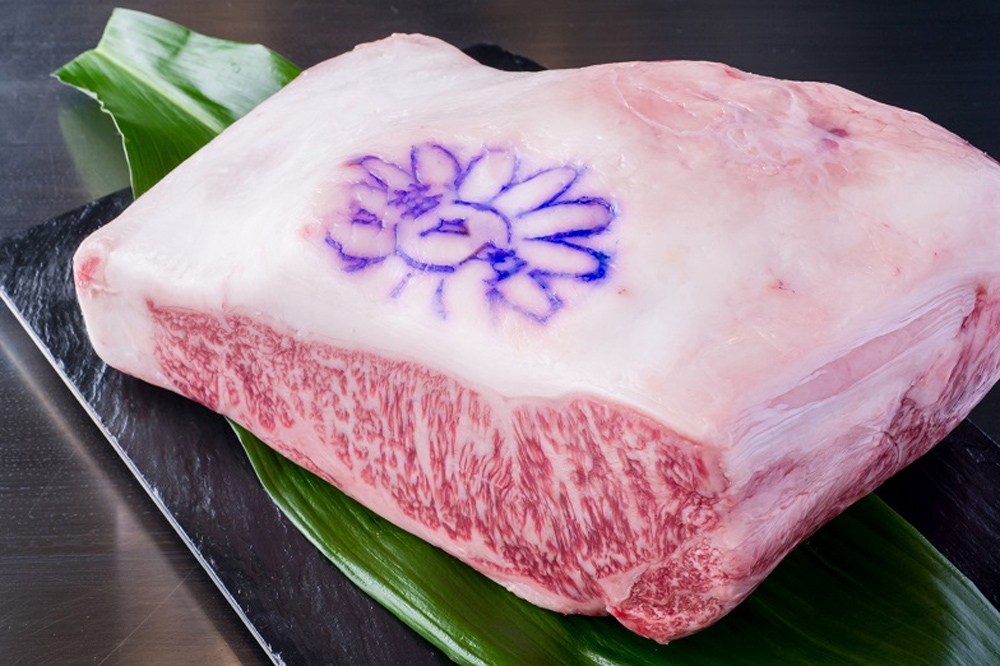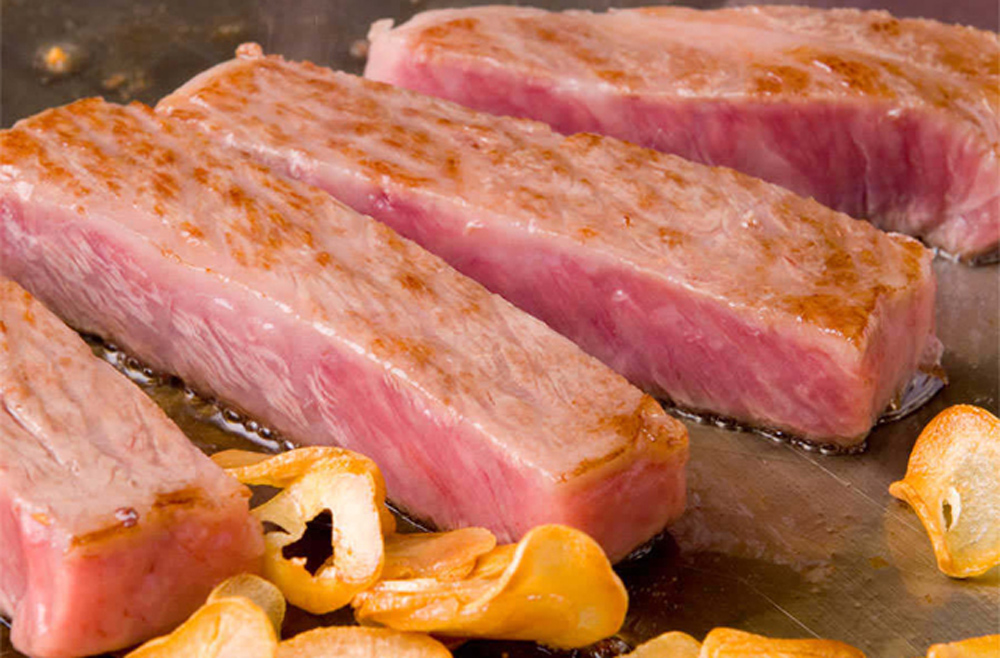Wagyu Beef in Japanese Logo Japanese Logo Box
Wagyu: The Best of Beef

When you lot hear "Kobe beefiness," y'all may conjure up the image of a Japanese cattle rancher lovingly massaging its ample hind legs, alleviating any stress build up in its body, while his married woman gently brushes the hibernate with sake, bringing out the sheen of its glaze. Such is the mystique surrounding the production of the world's near exquisite beef. At that place is really more truth than fiction to these tales of pampered cows.
Fact or fiction?

According to DK Lunt of Texas A&Yard University's Department of Animal Science, an expert on raising wagyu, the premium breeds of cow are indeed massage and fed beer to whet their appetites. Information technology is of import that these cows continue eating, fifty-fifty during hot lethargic summers, to produce more fatty deposits. Simply the brushing of their coats with sake is rarely washed anymore. In the past, the quality of coat affected how the animals were viewed at livestock shows. Brushing with sake resulted in softer pare with more sheen. But at commercial events now, only the carcass is graded so the quality of the skin is not judged.
Despite popular belief that the marbling of the meat comes from daily massages, wagyu's intense marbling is from genetics and how the cattle eats special feed of rice straw with nutrition-rich feed supplements made by blending soybean, corn, barley, wheat bran, and various other ingredients. The fat ratio increases with age and wagyu are slaughtered at well-nigh thirty months every bit compared to commodity beef cattle in other countries which are fed for near 24 months.
Just just how delicious is this legendary beef? The difference between beef in Nihon from elsewhere is its marbling procedure where fatty and lean are interspersed, resulting in meat that is sweet in season and buttery soft that it melts in your rima oris. People often associate the rich texture with foie gras and fatty "toro" tuna.
Difference between Kobe beefiness and wagyu

Any of the iv.4 million (2014) cows born and bred in Japan are considered "wagyu" (Japanese beefiness). Simply there is a stardom to be fabricated betwixt the three most premium brands ? Kobe, Matsuzaka and Ohmi, from the others because genetically, cows from these regions accept optimal marbling ratio. In terms of quality and domestic prices, the Big Three are similar. However Kobe beef, perhaps considering it is the easiest proper name to remember, is the most pop brand overseas. But non all cattle from these regions are anointed with the prestigious regional label because all Japanese beefiness are graded by four elements; marbling, texture, color of fatty and color of meat. Only cattle ranked as A4 and A5 are given the official regional stamp of approval. Others are simply called "wagyu."
Beef is produced all over Japan and considering of the lower price tag, wagyu from the Tohoku region are in fact much more consumed than the more prestigious brands. In terms of pounds consumed, Yonezawa beef is the most while Matsuzaka is seventh and Kobe eleventh. Yonezawa beef has a very loftier fat to lean ratio. When grilled, there can be surprisingly little "meat" left, despite beingness tender due to the marbling. Iwate or Kumamoto beef on the other mitt tends to be rather lean, resembling beefiness raised outside of Nippon. Miyazaki beef has recently gained popularity every bit well. The lower ranked wagyu tin be bought at supermarkets, are served in more casual restaurants and in lunch boxes besides. The higher grades of wagyu, other than the Large 3, when served at top restaurants will have similar marbling qualities of the premium brands. With a far more reasonable price tag, they would be a highly recommended culinary choice on any menu. It would be an interesting sense of taste test to compare high course wagyu with beef accounted the Matsuzaka or Kobe characterization.

Wagyu Abroad
More frequently, in that location are Kobe beef burgers or Australian wagyu steaks on menus at eating house overseas. Just the chances are, these meat are a far cry from the beef you can have in Nippon. Very small quantities of Kobe beefiness is being exported, by and large to Asia and a small-scale amount to the Usa and Europe. The Kobe Beef Council publicizes a listing of importers and the miniscule corporeality they sent out every monthly ground. The chances are what is more ordinarily represented every bit wagyu are beefiness from Australian and American cattle ranchers who have imported purebred cows from Nippon and crossbred them with domestic breeds. While some effort to keep the bloodlines pure and attach to the expensive, nutrient-laden feeding methods of raising wagyu, many ranchers do not. Since the wagyu label is not clearly regulated overseas, the chances are the Kobe beefiness burgers on eating house chain menus are much watered down "wagyu influenced" patties.
But even in Japan, in that location are inexpensive ways of claiming to taste the best in beef. Coincidental restaurants around the country will offer Matsuzakaya or Kobe beefiness hamburgers or croquettes. Usually they are attached to a meat shambles that genuinely used flake premium meat. Because the price is and then harmless, it is tempting to endeavour them as a novelty. But exist warned that when minced, the taste difference is negligible. While they taste perfectly fine, there is nil about these casual foods that resembles the finest qualities of the best marbled beef.
The most traditional mode of having wagyu is thinly sliced in sukiyaki or shabu-shabu, and it is still the best manner to capeesh the succulence of the meat. Steakhouses volition also offer wagyu steaks but proceed in mind, the portions volition exist far smaller than served overseas. For meat lovers used to 24-oz Porterhouse cuts, a six-oz cut of Japanese steak broiled on a well-oiled iron grill and sliced into bite-size pieces, may seem like an appetizer. Merely surprisingly, the smaller portion is plenty satisfying. Ane prominent chef in Japan pointed out that to have an American sized portion of wagyu would exist similar "eating a stick of butter," since the marbling process results in most having l% fat. A fourth and more unusual manner of trying wagyu is "tartare" way as a sushi topping. The sliver of rare meat melts in your oral fissure. Again, the portions are tiny only sense of taste exquisite. In kaiseki class meals, a minor piece of wagyu is usually served, typically broiled on a hot rock. It will be a one bite portion, peradventure marinated in miso, which gives the meat a strong, singled-out flavor. But marinated beef will typically non exist the well-marbled brands, but a bacteria make such as Kyoto beef.
When in Nihon, eating a repast of marbled wagyu should be a culinary experience not to be missed. No longer is high quality sukiyaki or shabu-shabu the exclusive realm of business organization business relationship dinners. Many fine restaurants in the urban centers offer special lunch courses that present the aforementioned quality of meat, only at a reduced price from its dinner menu. If eating Japanese beef is an feel American presidents like Barack Obama and George Westward. Bush-league say they cherish, it may be worth a endeavour.

Listing of restaurants
The INNOCENT CARVERY Nishi Azabu (Nishi-Azabu)
https://japanrestaurant.cyberspace/en/store/the-innocent-carvery-nishi-azabu/
The INNOCENT CARVERY Marunouchi (Marunouchi)
https://japanrestaurant.internet/en/shop/the-innocent-carvery-marunouchi/
KOBE PLAISIR GINZA (Ginza)
https://japanrestaurant.net/en/store/kobe-plaisir-ginza/
Daigoro (Nishi-Azabu)
https://japanrestaurant.cyberspace/en/shop/daigoro/
Teppanyaki-yaki SUMIDA (Suitengu)
https://japanrestaurant.internet/en/shop/teppanyaki-sumida/
RRR Kobe Beef Steak (Roppongi)
https://japanrestaurant.net/en/shop/rrr-kobe-beef-steak/
Steak Misono (Shinjuku)
https://japanrestaurant.net/en/store/steak-misono-shinjuku/
Steak Misono (Ginza)
https://japanrestaurant.net/en/store/steak-misono-ginza/
Kobe Beefiness Kaiseki 511 (Akasaka)
https://japanrestaurant.net/en/shop/kobe-beef-kaiseki-511/
NoMad Grill Lounge (Akasaka)
http://japanrestaurant.internet/jr/?a_type=nomad-grill-lounge&lang=en
GINMEISUI GINZA (Ginza)
https://japanrestaurant.net/en/shop/ginmeisui-ginza/
Sumiyakiya Halal (Azabu)
https://japanrestaurant.internet/en/store/sumiyakiya/
Steak Misono (Kobe)
https://japanrestaurant.internet/en/shop/steak-misono-kobe/
Story by Ballad Hui Akiyama
From WINING & DINING in TOKYO #48
Source: https://jselect.net/english-wagyu-the-best-of-beef/?lang=en
